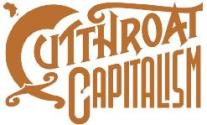
The result is seductive and memorable, but does it satisfy?
In its print form, "Cutthroat Capitalism" is an eight-page info-graphic, styled in the blocky bold colors of an NES-era cartridge video game. Interspersed among the pixilated illustrations are a buffet of equations, text boxes, org-charts, and diagrams, loosely tied together by the story of the September 2008 hijacking of the Hong Kong-flagged chemical tanker, Stort Valor. The game aesthetic sets readers up well for an actual browser-based game, which accompanies the online version of the story.
A narrative map
While the economics of Somali piracy have been covered before, notably by NPR’s Planet Money, Carney’s graphics attempt to simplify the phenomenon into what feels almost like a how-to manual. After a brief text introduction, we’re thrust into the piece’s version of scene setting. “The Hot Zone,” is a map of the region showing the locations of pirate attacks. We also see, in equation form, that the pirate’s wage is seventeen times that of the average Somali. With context out of the way, we move on to the action in three explicitly labeled acts: The Attack, The Negotiation, and The Resolution.
“When you talk about telling a story with equations, it’s very difficult to find the kernel,” says Carney. He and his editor had to impose a narrative to make the piece work, attaching minimal compartments of data and reasoning to an almost stock, three-act spine. “Writing it was different than a feature,” he says.
“The Attack” is part business plan, part video-game manual. We get the “Shipper’s Math,” an inequality that must hold true if the shipper is to sail through Somali waters. The “Pirate’s Math” gives a rough formula for figuring out when to attack. Finally we get the “Insurance Company’s Math” wherein we see a back-of-the-envelope calculation for the probability of being attacked. The section concludes with a brief Q & A with an unnamed pirate. The questions and responses are one of three interactions Carney’s piece has with actual human beings—the second being a brief interview with a security contractor and the third a chat with the Stort Valor’s captain. The story continues through the final two acts in much the same manner, giving formulas, for example, for how to choose a ransom amount and how to get away safely.

If there is an underlying mechanism that drives the parties in the piece, Carney lays it bare, a logical approach for a story about economic decision making. One wonders, however, how much nuance must ultimately get folded into such abstract simplifications.
“While we did learn about piracy as a business, we didn’t learn about the investigative hook that sold the article in the first place,” says Carney. He had originally pitched the story as one of collusion between insurance companies and security contractors. This dynamic is present in the disconnected boxes of the Negotiation and the Resolution, but it’s very much up to reader to make that connection.
“I like the story, I think it came out well. But in the end, you can tell a story better when you have words to deal with, instead of being restricted to graphics,” says Carney.
Playing the game
The "Cutthroat Capitalism" game keeps the same visual feel of the print piece and parallels its structure. In The Attack, the player navigates a boat in Somali waters from a top-down perspective, trying to intercept passing ships. Once intercepted, the player is taken to The Negotiation, where he makes ransom demands and can choose how to treat hostages in the attempt to move the transaction along. The player eventually either coerces a decent ransom payment and makes a safe getaway or overplays his hand and invites a Naval intervention, the two outcomes possible in The Resolution.
“The game is much more basic than the article, but what it does is draw in a reader and tells them a story in a different way,” says Carney. “Someone who plays it isn’t necessarily going to learn a lot about pirates. They might walk away with the idea that piracy is a business.”
Carney hopes that the article and game support each other, rather being an either-or proposition. For the player of the game, the article provides much more detail about what is actually happening. For the reader, the game invites a stroll in the pirate mindset, if only superficially. “It makes the reader think about that a little more viscerally than if he had just read the article,” says Carney.
Road testing the project
Shashank Bengali, a Nairobi-based McClatchy reporter, has interviewed and written about Somali pirates in the past. By email, he told the Storyboard that while the article and game presented an abstract view of a very human situation, he thinks it is a good way to communicate the economic story.
“A lot of reporters have written about why Somalis went into the pirate business, because of the lawlessness and hopelessness of their country. This story tells us why they stay in the pirate game: because it's good business,” he writes.
The human part that gets left out, according to Bengali, is that young Somali men simply have few employment options. “Piracy succeeds not just because of business calculations and structural issues in the shipping industry, but also because there's no great alternative for young Somali men,” he writes.
Carney admits that he had to leave out many of the fruits of the six months of reporting that went into the piece. Given his prior narratives on black market skeletons and Indian crime bosses, one suspects this story could easily have taken a more traditional form. Carney seems happy to keep experimenting, however. Regardless of how stories are delivered, he says, “I think there’s inherent value in really strong content.”


